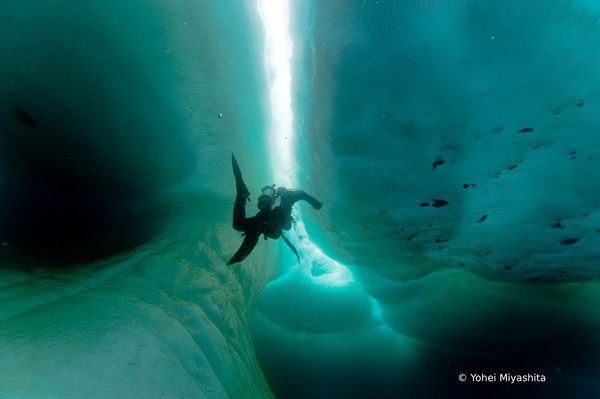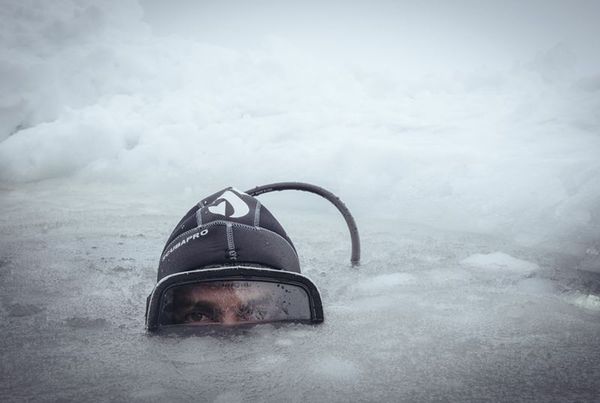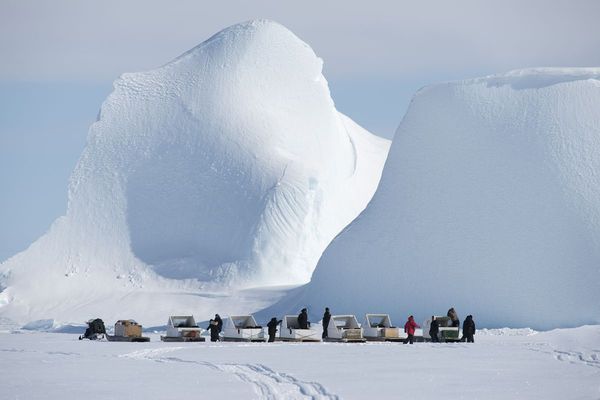
Savage beauty: ice diving on Baffin Island
Gaggenau speaks to Francoise Gervais, an expedition leader and dive-master, pushing the boundaries for travellers venturing to the Canadian Arctic
Interview Catherine McMaster
Words Leo Bear
Photography Yohei Miyashita

Surrounded by inky-blue icy waters, Baffin Island’s jagged peaks, frozen fjords and ever-shifting landscape present Arctic life at its most raw. The fifth largest island in the world, with a population of just 11,000, it’s one of the few places left where journeyers can properly disconnect from the manic whir of the modern world. Those determined enough to get to this silent hinterland are rewarded with achingly beautiful vistas blanketed in snow and the opportunity to marvel at polar bears, whales, walrus and the elusive narwhal in their natural environment – on land or by sea.
During summer months when it’s daylight for 24 hours, visitors can slip beneath the ice and explore a submarine world under the glow of a midnight sun, and during winter’s unrelenting darkness, imaginations are captured by those ethereal northern lights dancing across open skies. No one knows Baffin Island better than Arctic Kingdom, the global leaders in land-based tours in the Canadian Arctic. They’ve been taking small groups onto – and now under – the ice for the last 20 years. Expedition Leader Francoise Gervais reveals what makes Baffin Island so extraordinary.


Gaggenau: You’ve been living on Baffin Island for the last five years. Can you describe what it is like living in such a remote location?
Francoise Gervais: Some would say living here is an intense sacrifice. It’s very isolated and the temperatures can change dramatically from day to day. People say to me ‘you must love the cold’ but I don’t really love the cold; I love the wilderness.
Gaggenau: Can you put your finger on what is so special and unique about the island?
FG: It’s one of the last places on the planet without settlement. Practically no roads. We travel by snowmobile and qamutik (sled). I mean we have communities, but they feel very small compared to the landscape. The scale of nature makes you feel very vulnerable. You have to be able to change your pace. You’re forced to be humble. You have to be able to say ‘nature is more powerful than us. We’re not going to be able to change it.’
Gaggenau: How detailed are the itineraries you organise for travellers signing up to your tours?
FG: We operate in the spirit of expedition so there’s no real schedule. We have to go with whatever the weather allows us, and we’ve found that people really embrace that. They don’t want to be on a fixed programme. The ice moves, there are changes in the tide, so we don’t know what we’ll be doing tomorrow. We might see underwater icebergs, caves, drifting pack ice – you don’t ever know what you’re going to see. It’s always new.

‘It’s very isolated and the temperatures can change dramatically from day to day. People say to me ‘you must love the cold’ but I don’t really love the cold; I love the wilderness.’

Gaggenau: What can you tell us about ice-diving?
FG: Cold-water diving is very challenging. The groups we take out are mostly experienced divers [an Advanced Open Water PADI is required] and we dive under the ice with rope because if the current suddenly comes, it can be very dangerous. If we have less experienced divers we start them off in the open water, and once they’re comfortable we’ll take them to other places where they can dive under the ice.
Gaggenau: Baffin Island is the land of the Inuits. How much contact do you have with the locals?
FG: A lot. In many ways my role is acting as a conduit between our guests and the Inuit. The Inuit are very quiet people. They have incredible knowledge of the land from their fathers and their grandfathers before them. I’ve been living here for five years but I’ll never have the amount of knowledge they have. Mostly they fish and they hunt and they can teach us so much about that, but they are also so enthusiastic about diving because that’s new for them. They help us to find entry points that are safe. Their knowledge of the ice is essential when it comes to picking our dive locations.
Gaggenau: What are biggest dangers when it comes to diving under the ice?
FG: Well, first of all it’s the gear. Having the right gear. Then it comes down to experience. We always have an Inuit guide with us so we have the best local knowledge possible. Walrus and polar bears can be very dangerous. Some walrus eat seals and their eyesight isn’t very good, so my main fear is that a diver will be mistaken for a seal.
Gaggenau: What kind of accommodation does Arctic Kingdom provide?
FG: We have a base camp set up in the middle of the sea ice with yurts and a dining room. It’s not luxury like on an African safari but we have showers, fireplaces and heating. Our guests are always surprised by how comfortable it is.


